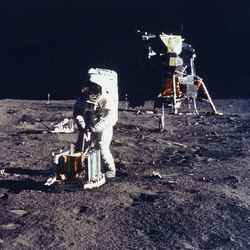
Astronaut on the Moon surface. Image credit: NASA Click to enlarge
A breakthrough by a team of British, US and French scientists will help protect astronauts, spacecraft and satellites from radiation hazards experienced in space.
Reporting in the journal Nature this week, the team describe how their study of rare and unusual space storms provided a unique opportunity to test conflicting theories about the behaviour of high energy particles in the Van Allen radiation belts* – a volatile region 12000 miles (19,000 km) above the Earth.
Lead author, Dr Richard Horne of the British Antarctic Survey (BAS) says
?Solar storms can increase radiation in the Van Allen belts to levels that pose a threat to spacecraft. As modern society relies increasingly on satellites for business, communications, and security, it is important to understand the environment that spacecraft operate in so that we can help protect our space investment.
?For a long time scientists have been trying to explain why the number of charged particles inside the belts vary so much. Our major breakthrough came when we observed two rare space storms that occurred almost back-to-back in October and November 2003. During the storms part of the Van Allen radiation belt was drained of electrons and then reformed much closer to the Earth in a region usually thought to be relatively safe for satellites.
? When the radiation belts reformed they did not increase according to a long-held theory of particle acceleration. Instead, by using scientific instruments in Antarctica and on the CLUSTER mission satellites, we showed that very low frequency radio waves caused the particle acceleration and intensified the belts.
?This new information will help spacecraft operators and space weather forecasters who must predict when satellites and missions are most at risk from radiation events allowing them to take measures to protect instruments and systems from damage, and astronauts from risks to their health.?
Original Source: BAS News Release
